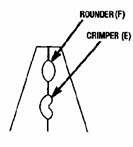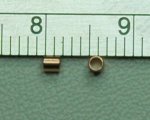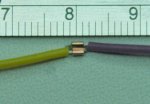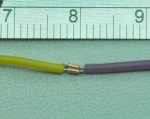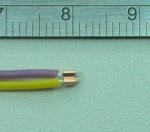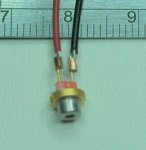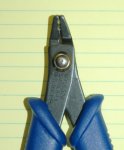madmacmo
0
- Joined
- Dec 28, 2009
- Messages
- 284
- Points
- 63
There probably are not many applications where a solder joined wire to wire connection would not be the most optimal; however for those instances where a mechanical connection would be of benefit for wire sizes AWG 24 and smaller, I believe I have found a solution. I came across a crimping tool and micro sized copper tubes designed and marketed for beading hobbyists. I immediately recognized these could be repurposed for making solder-less electrical connections in similar fashion as the common and larger crimp connectors designed for electrical industry terminations.
Note the link to the Beadalon Bead Crimp Tool - US 9.95:
CRIMPER PLIERS for BEADS 2 - 3mm
This tool features two dies: (E) to make the Initial Dimple Crimp and (F) to make the Finish Rounded Crimp. This tool measures 5” from nose to the end of comfort formed handles and 2” wide at the base of the handles.
Image of the two dies within the nose tip
I purchased two tools and used a grinder to trim down the nose edges to allow making crimps in close quarters. The second tool I ground down so just the lower dimple crimp dye remains.
Note the link to the 2mm x 2mm Copper CRIMP Tube Beads (Qty 50 for US $4.06):
Amazon.com: (50) 2 x 2mm Copper CRIMP Tube Beads: Arts, Crafts & Sewing
Actual measured length 1.85mm to 1.88mm, OD 1.86mm to 1.88mm, ID ~1.15mm – equivalent to #18 AWG
Best results are obtained when the two wires are positioned so they end up on either side of center within the Initial Dimple Crimp.
Image Side by Side wires within Initial Dimple Crimp
Image of In-Line wires within an Initial Dimple Crimp
Image of the Final Rounding Crimp
I was disappointed to find this method did not work well for diode connections, as no matter how much force was used the crimp tube would not hold fast to the smooth and rigid diode leads.
Note the link to the Beadalon Bead Crimp Tool - US 9.95:
CRIMPER PLIERS for BEADS 2 - 3mm
This tool features two dies: (E) to make the Initial Dimple Crimp and (F) to make the Finish Rounded Crimp. This tool measures 5” from nose to the end of comfort formed handles and 2” wide at the base of the handles.
Image of the two dies within the nose tip
I purchased two tools and used a grinder to trim down the nose edges to allow making crimps in close quarters. The second tool I ground down so just the lower dimple crimp dye remains.
Note the link to the 2mm x 2mm Copper CRIMP Tube Beads (Qty 50 for US $4.06):
Amazon.com: (50) 2 x 2mm Copper CRIMP Tube Beads: Arts, Crafts & Sewing
Actual measured length 1.85mm to 1.88mm, OD 1.86mm to 1.88mm, ID ~1.15mm – equivalent to #18 AWG
Best results are obtained when the two wires are positioned so they end up on either side of center within the Initial Dimple Crimp.
Image Side by Side wires within Initial Dimple Crimp
Image of In-Line wires within an Initial Dimple Crimp
Image of the Final Rounding Crimp
I was disappointed to find this method did not work well for diode connections, as no matter how much force was used the crimp tube would not hold fast to the smooth and rigid diode leads.
Attachments
Last edited:


